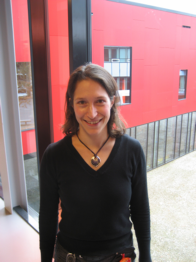Investigating cellular electroporation using planar membrane models and miniaturized devices
Promotion date: 22. October 2010
Promotors: Prof. dr. ir. Albert van den Berg
Assistant Promotor: Dr. ir. Séverine Le Gac
| The process of electroporation is a widely employed technique, to engineer cells. Foreign materials are introduced, with the help of an electrical treatment. Although this technique has been in use for several decades, the success rate is still relatively low. This is partly caused by a lack of understanding of the precise mechanisms involved in the pore formation process and specifically the effect of the individual membrane constituents on this process. |
The knowledge on the process of pore formation can be increased, using planar models of cell membranes, so-called bilayer lipid membranes (BLMs), since their composition can be precisely controlled. The results on the membranes resistance on the application of an electric field, have not only lead to a better understanding of the effect of the individual membrane components, but also about the effect of their interaction with each other. This has even resulted in the derivation of a ternary phase diagram for the l-α-PC/SM/Ch system as is employed in experiments, describing the phases the phospholipids are in, depending on their precise ratio.
A microfluidic platform to form and study these membrane models is fabricated and includes one BLM experimentation site (50-µm diam. aperture), which is fabricated in a Teflon thin substrate and placed at the intersection of two orthogonal microchannels, made in two glass substrates.
In the last experimental chapter, the membrane models are abandoned, and a miniaturized device is developed for experimentation on whole cells. This microdevice is particularly developed to electroporate adherent MDCK cells, which are grown as monolayers in 200-µL wells, to study the effect of membrane polarization.
What type of research did you perform, fundamental of application oriented?
The project was quite fundamental, I would say, also partly application oriented. A lot of experiments were involved, aimed at imitating the cell-membrane as accurately as possible. The main physical model consists of a bilayer structure, made out of phospholipids and cholesterol, formed across a little hole of 150 micrometer. The membrane formation and also the pore formation process, is a complex series of hydrophobic and hydrophilic processes taking place.
In the later stages of the project, I carried out some interesting chip designing. A proof of principle microfluidic device for membrane formation, was generated successfully. At the moment a next thesis project is started on this very subject. My hope is the system could be used to make some particular industrial drug screening processes, more efficient in the future.
Was there a special moment during the thesis project?
Being able to measure the ternary diagram and understanding what was going on, was definitely a special feeling. I felt very close to observing the way, living cells function. A lot of living processes, in fact all organs, are guided by this in fact simple routine.
More specifically the explaining of the diagram means some medicine scanning principles, can be designed in a less complicated way. I had some nice publications on this, e.g. in Soft Matter and Biochemica et Biofysica Acta Biomembranes.
What are your future plans?
I like to learn new things, like I did in this project. I started as an electro technical engineer, learning a lot of biophysics and biochemistry on the way.
The three months to come, I work on a post-doc project on a totally different subject. After that, I intend to find a job in industry, working on a product for the near future.
What is important for Mesa+ to stay successful in the future, in your opinion?
I worked in the laboratory, more than in the cleanroom. Also in my group, I was the only one working on this subject. So, I felt a little different, somehow.
In my opinion bio-nano is an important area of research in the near future for Mesa+. The research I performed, fits in this very well. Medicine research is a nano matter, as cells are functioning on this very nano scale. Also, it is important to better understand the risks involved in developing medication principles at this level.
At Mesa+ I always felt at home, due to the open and pleasing working atmosphere, a real feature of the University of Twente, I’m sure. At the annual Mesa+ meetings I always experienced solidarity amongst all researchers, coming from different parts of the world.

